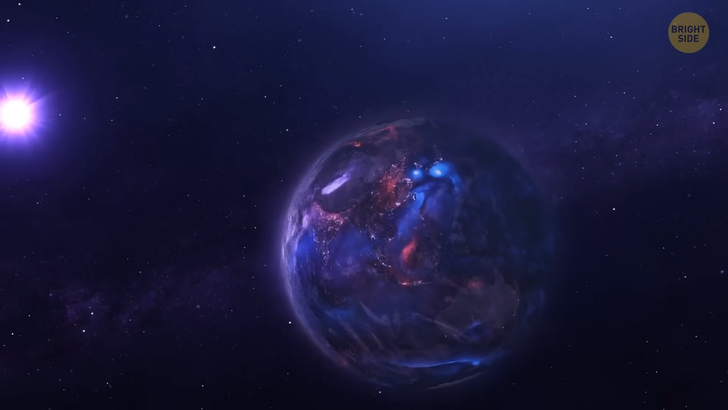What If We Lived on a Planet With No Sun

Consider the rogue planet, the cosmic wanderer that nobody wants to take home. Basically, a rogue planet is a planet that has been ejected from its own star system and is now floating aimlessly through space like a cosmic loner. These planets aren’t just a theory; scientists have actually detected some in our galaxy!
In fact, estimates suggest that there may be lots of these cosmic nomads floating around the Milky Way! And they aren’t just small, rocky worlds like Earth. Some of them are actually massive gas giants, many times larger than Jupiter! These behemoths could potentially have their own moons and even their own mini-systems orbiting around them.

For example, one of the most famous rogue planets we know of has a complicated name (here, you read it for yourself) [PSO J318.5-22]. It’s located about 80 light-years away from Earth, and it was discovered in 2013. This rogue planet is estimated to be around six times the mass of Jupiter and is believed to be around 12 million years old!
And yes, just because these cosmic loners don’t have a star, doesn’t mean that they’re super cold. They can still generate heat and light from their own internal processes. Some may even have magnetic fields and auroras, just like Earth. In other words, rogue planets could potentially be habitable, if they have the right conditions. So... What would life on such a planet look like? And could we potentially live in such a world?
Well, living on a rogue planet can be a lonely existence. They have no warm sun to bask in, no cozy atmosphere to cuddle up in, and no cosmic neighbors to have barbeque with. That’s why we’d have to get creative! Let’s start with the most obvious problem: we’ll have a hard time without light and heat. So how do we fix this? Well, we’d probably have to invest in some really fancy space heaters and wear fashionable, super-warm space suits. Or we could invent a whole new way to generate electricity without relying on solar power.
For example, how about using geothermal energy? Now that’s hot stuff! Each planet has an internal source of heat. Without it, they all would be nothing more than cold, lifeless rocks floating through space. This internal heat can be harnessed and used to power everything from homes to factories to spaceships. It’s like having a hot tub big enough to power an entire city! And that city, most likely, will be located underground, closer to the heat source.

And as for light, well, we’d probably have to build some really bright flashlights. Or maybe even learn to genetically engineer some bioluminescent organisms to light up our homes? Just imagine space bases overgrown with neon mushrooms and plants! By the way, speaking of plants...
Plant life would be pretty hard to come by without a star. So, what would we eat? Well, we could use the same geothermal vents that we’ve talked about, or some chemical reactions, to sustain ourselves. And hey, maybe we’d develop a taste for sulfur-rich foods, or we’d start fermenting our own drinks from the bubbling volcanic mud. Yum. But, besides food, we have a more important problem... living on a rogue planet would be breathtaking — literally. We’d have no air.
You see, not all rogue planets have good, stable atmospheres. It all depends on their size, composition and other things. But even if our new home does have an atmosphere, it may be incredibly thin and unstable. We’d have no pretty blue skies or dramatic sunsets to admire. Instead, we’d be staring out into the infinite void of space, where the stars would be brighter than ever before.
And forget about weather patterns — without an atmosphere to create them, we’d have no rain, no snow, and no thunderstorms. And that’s just some minor problems. What’s worse, the temperature on the planet would be wildly fluctuating, swinging from unbearable heat to unbearable cold. It would be like living in an oven that’s always being turned on and off!

And finally, we’d be exposed to all kinds of space debris and cosmic radiation. So if you don’t wanna get crispy, you might want to invest in some serious SPF! So how do we fix it? Well, we’d have to find a way to generate our own oxygen and probably create something like a space-age biosphere. For example, we could grow some plants that could produce oxygen, or we’d learn to filter the air like a high-tech air purifier.
Finally, we have the last most important problem: finding water. And here’s where the underwater oceans come to our aid! Now we’re really diving deep into the possibilities! Ha ha. But seriously, scientists suggest that some of these planets may indeed have underwater oceans. It would be like living on a giant water balloon that’s been buried underground, with the ground beneath your feet made of ice and rock.
In other words, we could just tap into these underground oceans. They could provide us with a source of water for drinking, farming, and manufacturing. Maybe even with some other resources and materials we’ve never seen before. And, by the way... Who knows what kinds of strange creatures might be lurking in those underground seas?
But don’t worry. Even if we don’t have any underground oases, there are also other options. We could get some water from comets, ice mining... and even from the atmosphere — the one we just created before. Finally, we need to find and mine some resources to build our homes and other stuff. And a rogue planet might not have the same kinds of resources as a planet that orbits a star.

It’s like trying to find some treasures in a desert — not exactly a sure thing. We may have to rely on resources from nearby asteroids and things like that. And if we want to extract resources from the planet itself, we might need to drill down through miles of ice and rock. But hey, if you’re up for the challenge, there’s always a chance you’ll strike it rich on a rogue planet! And who knows — maybe you’ll discover some new resources that are even more valuable than gold or diamonds.
Great. Looks like we’ve solved the most important problems. There may be other small difficulties. For example, we’d also have to deal with some seriously long days and nights, depending on how fast our planet was rotating. And we wouldn’t have a normal, regular day-night cycle.
The rotation of our planet could be wildly unpredictable. Maybe we’d have weeks-long nights followed by weeks-long days, which could really mess with our sleep schedules. We might have to develop some really strong coffee to keep us going through those long, dark nights! But hypothetically, we can adapt to all these things and overcome all the challenges.
And now, finally, welcome to the Rogue Planet — where the sun never rises, but the adventures never end! Thanks to our advanced technology, we’ve managed to create a comfortable and habitable environment in this once-barren world. The sky above us is now a beautiful shade of blue, filled with fluffy white clouds and the occasional flock of flying creatures. Don’t ask.

As we venture out from our underground habitats, we’re greeted by a world that’s full of surprises. Strange plants and animals have adapted to the unique conditions of this planet, some with bioluminescent features that glow in the dark. And be careful if you wanna go swimming in the underground ocean — they might be home to some bizarre creatures, who want to feast on ...well we’ll come back to that. Maybe.
As you can see, we’ve created sprawling cities and thriving communities, powered by the planet’s geothermal energy. We also created a bunch of artificial light sources that keep things bright throughout the dark, chilly nights. Of course, we still have some problems with navigation and timekeeping, but things aren’t as dull as they used to be, are they?
Overall, living on a rogue planet would definitely have its challenges, but it could also be a pretty exciting way to experience the universe. And who knows — maybe one day we’d find such a planet and actually turn it into a bustling intergalactic metropolis someday. But until then, let’s enjoy and tidy up our dear Earth.
Comments
Related Reads
20 Times Kindness Won the Argument Without Saying a Word

12 Moments That Prove Kindness Still Matters in a World That Forgot How

I Refused to Split the Bill of Food I Didn’t Eat—I’m Not a Walking ATM

My Pregnant Roommate Tried to Kick Me Out—She Wasn’t Prepared for My Next Move

15 Times Romance Had Big Plans, but Real Life Wrote a Funnier Script

14 People Who Walked Straight Into Awkward Moments

15 Stories That Prove the Kindest Hearts Are the Strongest Survivors

12 Times Kindness Won Over Anger in the Best Way

I Refuse to Look Away After What My Stepson Did to My Son — It Destroyed Our Family

I Refuse to Be Forgotten After Raising My Stepson for 14 Years

10 Moments That Remind Us Quiet Kindness Is Mightier Than It Seems

17 Stories That Prove Living in an Apartment Building Is a Sitcom You Never Auditioned For
